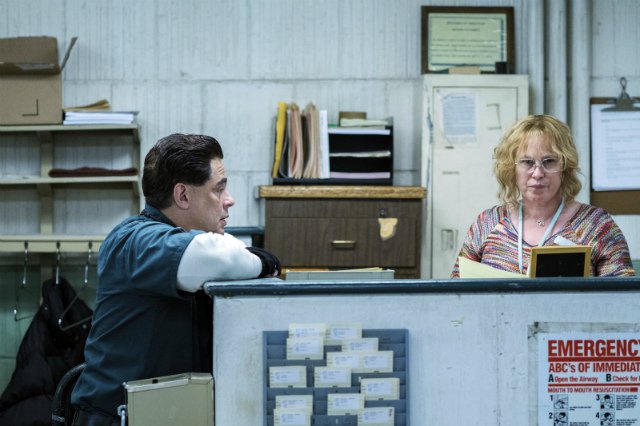'Escape At Dannemora' Is A Captivating Retelling Of Upstate NY Prison Break
Nov. 16, 2018, 3:20 p.m.
It's an engrossing retelling of a thrilling escape attempt that does not shy away from the darkest, most complicated aspects of its three primary subjects, while also retaining the vibes of a classic '70s escape movie.

In the summer of 2015, convicted murderers Richard Matt and David Sweat, with the help of prison tailor shop supervisor Joyce 'Tilly' Mitchell, staged a daring breakout of Clinton Correctional Facility in Dannemora, NY. The story was filled with sensationalistic details: illicit sex, an escape straight out of The Shawshank Redemption, a state-wide manhunt, and frozen hamburger meat.
If you were as riveted by the unforgettable prison break as we were, then you won't want to miss the Ben Stiller-directed Escape At Dannemora, Showtime's new miniseries that premieres this Sunday at 10 p.m. EST. It's an engrossing retelling of a thrilling escape attempt that does not shy away from the darkest, most complicated aspects of its three primary subjects, while also retaining the vibes of a classic '70s escape movie (most prominently with the wonderful title sequences).
And make no mistake: despite all the fun details around the ingenious escape plan, this is primarily a story about violent men—and one desperately needy woman—trying to escape the depressing circumstances of their lives. Benicio del Toro plays Richard Matt, who traded paintings with a guard for special privileges, as a kind of ringleader in prison, a man whose considerable charms masked his violent streak. It's as if we were following one of del Toro's many strange and memorable supporting characters—like Fred Fenster from The Usual Suspects—after the movie ended and he was locked up.
Paul Dano portrays David Sweat at first as Matt's apprentice (he's literally learning how to draw from him), a much quieter man trying to avoid all the many troubles that await behind bars. While del Toro has the flashier, chattier role, Dano does a fantastic job of portraying Sweat's determined usefulness as he labors night after night on cutting through pipes in the dark. By the time they get out, it becomes clear that Sweat is much more equipped for escape than Matt ever was.
But as good as the two actors are, the most brilliant portrayal belongs to Patricia Arquette, who transforms her body, her movements and her voice to become Mitchell. She is the messy heart of the story—there's a reason the title points to an escape from the town of Dannemora and not "escape from Clinton Correctional." As Alan Sepinwall put it, Arquette leaves any pretense of vanity behind as she "sports stringy hair, oversized glasses that are 30 years out of date and a discolored, crooked smile." She is both grotesque in her mannerisms and, thanks to Arquette, a deeply empathetic and complicated character: flawed, selfish, childlike, and filled with insecurities that can be seen miles away.
Which is almost certainly why she ends up sexually entangled with both Sweat and Matt. The Office Of The Inspector General noted in its report about the breakout that Tilly (as she insists on being called) "engaged in numerous sexual encounters" with both men, and starting with Sunday's premiere, that incredibly unromantic sex is depicted with nothing held back. As she regresses into a high school girl writing love letters to the prisoners, it's not hard to extrapolate from Tilly's inner life her dreams of escaping her economically-depressed existence with loyal husband Lyle (a very sympathetic and emasculated Eric Lange). Arquette told The Hollywood Reporter, "I like that she’s unapologetically comfortable with her sexuality. It’s not something we get to see with middle-aged women of a certain body type. So what I really love about her is that she’s the least likely femme fatale."
Stiller, who has directed several comedies including Tropical Thunder and Zoolander, acquits himself well behind the camera with his first major dramatic series project. As he told the Times, he had to convince a lot of people involved with the case he wasn't "going to come up and make a comedy about this and make fun of us." He plays things relatively straight as a result (he cites several '70s classics, like Dog Day Afternoon, Straight Time and The Taking of Pelham One Two Three, as inspiration), though he does direct the entire series in CinemaScope format (the wide, narrow aspect ratio of approximately 2.4 to 1). As Vulture wrote, "The wide frame amplifies the sense that all these characters are figuratively as well as literally trapped, and there are many striking compositions that use bars, windows, and the edge of door frames to create a mosaic effect."
In addition to those wonderful title sequences, he also throws in some nifty montages juxtaposing life in the tailor shop work with the work of sawing out. His best insight is to hone in on the monotony of life in prison, and the complacency amidst the staff that provided an opening for Sweat and Matt to exploit.
Perhaps the most unusual aspect to the series is its pacing: the first two episodes are preamble and setup, with episodes three, four and five concerned with the work that went into the breakout. The viewer is thrown for a loop with the incredibly brutal episode six, which is an all-flashback episode that serves as a stark reminder of why Sweat and Matt needed to be in prison in the first place, before picking up with the manhunt and aftermath of the escape in episode seven. Binge-watching the show, the pacing didn't bother me (especially since I was already fascinated with the details of the story), but it will be interesting to see whether viewers get bored with the early chapters, or are able to fall into its rhythms.